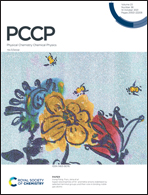Electrical properties and charge compensation mechanisms of Cr-doped rutile, TiO2†
Abstract
Cr-doped rutile, Ti1−xCrxO2−x/2−δ, powders and ceramics with 0 ≤ x ≤ 0.05 were prepared by solid state reaction and sintered at 1350 °C. Cr distribution is homogeneous with no evidence of either segregation or crystallographic shear plane formation. For high x compositions, >∼0.01, Cr substitution is charge-compensated ionically by oxygen vacancies with two Cr3+ ions for each vacancy and the materials are electronically insulating. For low x compositions, the materials are semiconducting. This is attributed to a new charge compensation mechanism involving Ti3+ ions created in response to the local electroneutrality requirement for two trivalent cations to be in close proximity to each oxygen vacancy. At very low dopant concentrations, ≪0.01, the dopants are well-separated and instead, some Ti3+ ions act as a second dopant to preserve local electroneutrality. For intermediate x compositions, a core–shell structure is proposed consisting of semiconducting grain interiors containing Ti3+ ions surrounded by a more insulating shell with Cr3+ ions as the only acceptor dopant. Lattice parameters show unusual, non-linear Vegard's law behaviour characterised by a maximum in cell volume at intermediate x ∼ 0.005, that is attributed to the composition-dependent presence of Ti3+ ions.



 Please wait while we load your content...
Please wait while we load your content...